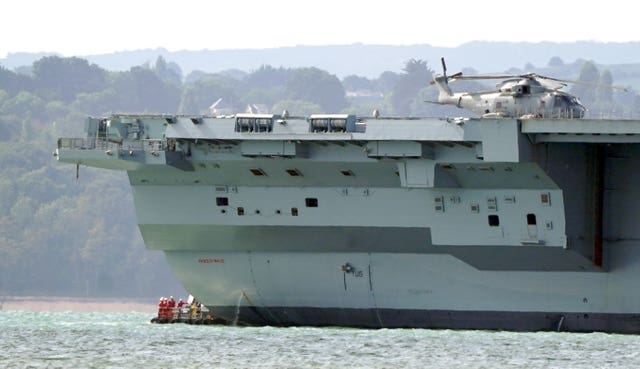Royal Navy flagship HMS Queen Elizabeth is to stand in for its sister ship during diplomatic visits and military exercises off the US coast after the HMS Prince of Wales broke down off the Isle of Wight.
The £3 billion warship left from Portsmouth Naval Base on Saturday before an “emerging mechanical issue” occurred while off the south-east coast of the Isle of Wight.
The departure of the Nato flagship had already been delayed from Friday because of a technical problem, but a decision was taken to sail anyway.
Shortly after the 65,000-tonne ship sailed on Saturday, a mechanical fault was discovered with the starboard shaft.
The carrier limped back to Stokes Bay at Gosport, Hampshire, on Monday travelling at a rate of four knots, accompanied by tugs for the return journey to calmer waters.
Navy divers have been inspecting the ship and found that a coupling on the propeller shaft had failed.

The shaft is a combination of steel poles joined together with a shaft coupling, one of which has failed.
It is understood this was caused by a mechanical failure, not because of a failure to keep the coupling greased.
HMS Prince of Wales will return to berth at Portsmouth Naval Base to unload crew and equipment before heading to dry dock for repairs, probably at Rosyth in Scotland where it was built.
The arrival in Portsmouth will be dependent on the tides and weather forecast, particularly as the carrier will be operating only on a single propeller with the assistance of a tug.
The Nato flagship had been sailing to undertake training exercises with the US Navy, the Royal Canadian Navy and the US Marine Corps.
The programme was expected to include exercises with the F-35B Lightning jets.
It is understood that the crew of sister ship HMS Queen Elizabeth have been warned they may be sailing to the USA, altering its current plans for deployments to the Baltic and Mediterranean, although a decision has not yet been made.
Navy chiefs and the Government are believed to be assessing which of the US commitments including the Atlantic Future Forum in New York at the end of September are essential for a carrier and which can be carried out by other ships from the fleet.
Rear Admiral Steve Moorhouse, director of Force Generation, who is responsible for making sure Royal Navy ships are ready to deploy, confirmed that HMS Queen Elizabeth would take over the US duties.
He said: “Our priority this week has been to ensure the ship and her people are safe whilst working hard to understand the nature and extent of the damage.
“Royal Navy divers have inspected the starboard shaft of the shift and the adjacent areas and they have confirmed there is significant damage to the shaft on the propeller and some superficial damage to the rudder but no damage to the rest of the ship.
Rear Admiral Steve Moorhouse @smrmoorhouse delivers the latest update on @HMSPWLS. “We will repair her and get her back on operations, protecting the nation and our allies, as soon as possible.” pic.twitter.com/NcbzE2RJiM
— Royal Navy (@RoyalNavy) September 2, 2022
“Our initial assessment has shown that coupling that joins the final two sections of the shaft has failed.
“Now this is an extremely unusual fault and we continue to pursue all repair options.
“We’re working to stabilise the shaft section on the propeller after which the ship will return to Portsmouth.
“The ship will then probably need to enter a dry dock as this will be the safest and quickest way to effect the repairs.
“The good news is that our other aircraft carrier, HMS Queen Elizabeth, will depart Portsmouth next week to undertake elements of Prince of Wales’ programme in the United States.
“She’ll then return to Europe to continue our autumn programme of exercises and operations.
“As for Prince of Wales, we’ll repair her, get her back on operations protecting the nation and our allies as soon as possible.”
The navy had said prior to the departure of HMS Prince of Wales that notable port stops during the three-month deployment would be in New York, Halifax in Canada and the Caribbean.
A Royal Navy spokesman said: “Diving inspections on HMS Prince of Wales’ starboard shaft have shown that a shaft coupling has failed.
“We are looking at the best way to carry out what will be a complex repair and assessing options for the delivery of Royal Navy outputs against current priorities and future commitments and will update in due course.”




Comments: Our rules
We want our comments to be a lively and valuable part of our community - a place where readers can debate and engage with the most important local issues. The ability to comment on our stories is a privilege, not a right, however, and that privilege may be withdrawn if it is abused or misused.
Please report any comments that break our rules.
Read the rules hereLast Updated:
Report this comment Cancel